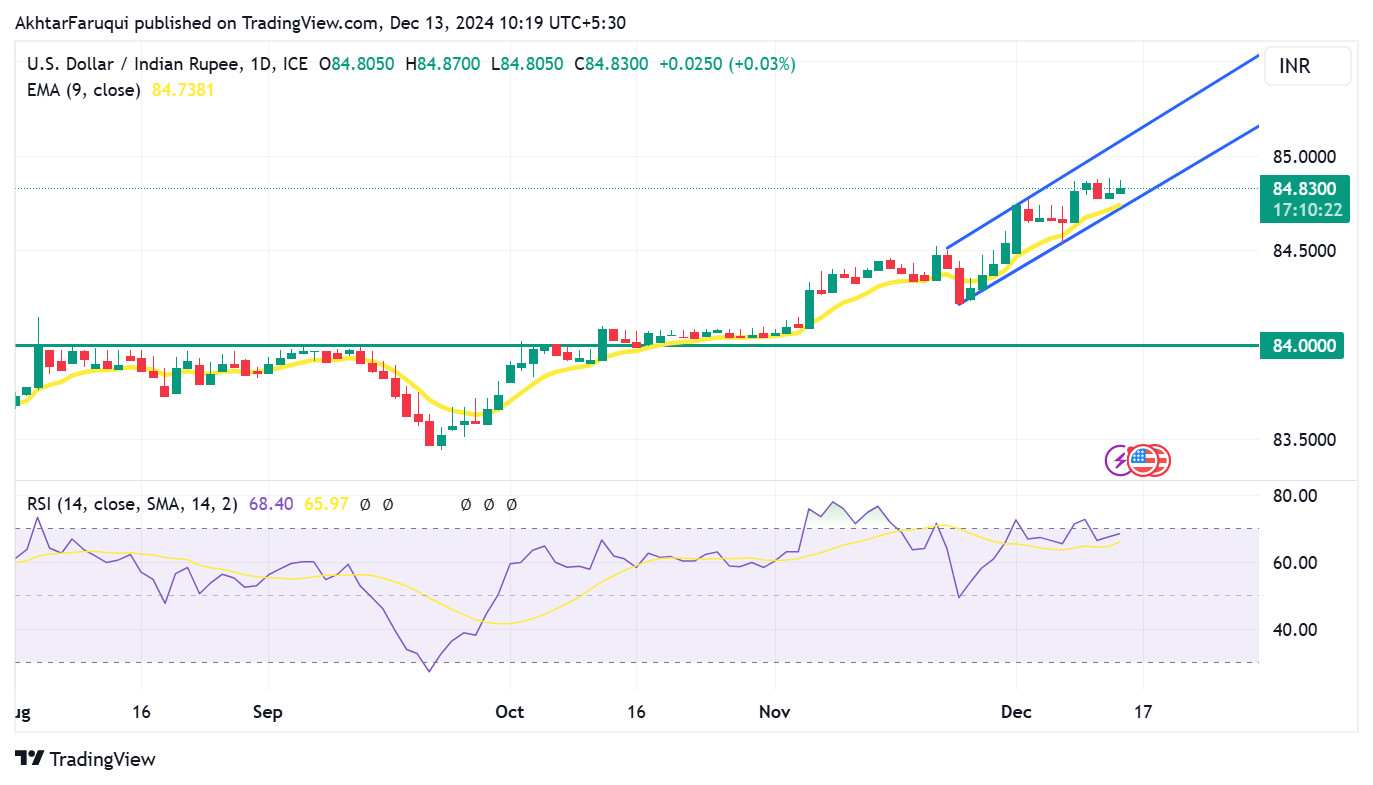- Indian Rupee remains subdued due to risk aversion amid Trump’s tariff threats.
- Asian currencies struggle as offshore Chinese Yuan falls following comments from a trade adviser to US President-elect Trump.
- India’s benchmark indices opened lower on Friday, mirroring Wall Street’s overnight slide.
The Indian Rupee (INR) extends its losses for the second consecutive session, hovering around new all-time lows on Friday. The rise of the USD/INR pair could be attributed to the strength of the US Dollar (USD) amid Trump’s tariff threats.
Asian currencies are under pressure amid a weaker offshore Chinese Yuan (CNH), boosted by comments from a trade advisor to US President-elect Donald Trump. The adviser warned China about currency manipulation, according to a Reuters report.
The INR could also face challenges following the appointment of bureaucrat Sanjay Malhotra as the next RBI governor, leading traders to increase their bets on interest rate cuts. Additionally, India’s retail inflation moderated to 5.48% in November, from October’s 14-month high of 6.21%, helped by slowing food prices, raising expectations of a rate cut from the RBI in February policy review.
The fall of the Indian Rupee could be limited by the intervention in the foreign exchange market by the Reserve Bank of India (RBI). The Indian central bank often intervenes by managing liquidity, including selling USD to avoid a sharp depreciation of the INR.
Indian Rupee Remains Subdued Amid Foreign Fund Outflows
- India’s benchmark indices, the BSE Sensex and the Nifty 50, opened lower on Friday, mirroring Wall Street’s overnight slide. Investors in India are expected to remain cautious ahead of the upcoming Federal Reserve (Fed) Federal Open Market Committee (FOMC) meeting next week.
- On December 12, Foreign Institutional Investors (FIIs) recorded net sales of Indian stocks worth ₹3,560.01 crore, while Domestic Institutional Investors (DIIs) made net purchases amounting to ₹2,646.65 crore.
- Financial markets are fully pricing in a 25 basis point rate cut by the Federal Reserve on December 18, according to the CME’s FedWatch tool.
- On Thursday, the US Producer Price Index (PPI) rose 0.4% month-on-month in November, the biggest increase since June, after an upwardly revised 0.3% increase in October. This reading was better than the 0.2% expected.
- The US Consumer Price Index (CPI) rose to 2.7% year-on-year in November from 2.6% in October. The headline CPI reported a reading of 0.3% month-on-month, in line with market consensus. Meanwhile, the core CPI, which excludes volatile food and energy prices, rose 3.3% year-on-year, while the core CPI rose 0.3% month-on-month in November, as expected.
- S&P Global Ratings on Tuesday estimated 6.8% growth for the Indian economy in fiscal 2025, followed by 6.9% growth in fiscal 2026, supported by strong urban consumption, steady sector growth services and continued investment in infrastructure.
Technical Analysis: USD/INR marks new highs near 85.00
The Indian Rupee remains contained near all-time lows against the US Dollar on Friday. The USD/INR pair is trading around 84.80 on Friday, with technical analysis of the daily chart suggesting a strengthened bullish bias. The pair is moving up within an ascending channel pattern, with the 14-day Relative Strength Index (RSI) positioning slightly below the 70 level.
The USD/INR pair could try to surpass its all-time high of 84.88, recorded on December 12. A break above this level could allow the pair to test the upper boundary of the ascending channel, located near 85.10.
Initial support could be found at the nine-day EMA at the level of 84.73, which aligns with the lower boundary of the ascending channel near the psychological level of 84.70.
USD/INR: Daily Chart
Indian Rupee FAQs
The Indian Rupee (INR) is one of the currencies most sensitive to external factors. The price of crude oil (the country relies heavily on imported oil), the value of the US Dollar (most trade is done in US dollars), and the level of foreign investment are all influential factors. The direct intervention of the Reserve Bank of India (RBI) in the foreign exchange markets to keep the exchange rate stable as well as the level of interest rates set by the RBI are other important factors influencing the Rupee. .
The Reserve Bank of India (RBI) actively intervenes in foreign exchange markets to maintain a stable exchange rate and help facilitate trade. Additionally, the RBI tries to keep the inflation rate at its target of 4% by adjusting interest rates. Higher interest rates tend to strengthen the Rupee. This is due to the role of the “carry trade”, in which investors borrow in countries with lower interest rates to park their money in countries that offer relatively higher interest rates and profit from the difference.
Macroeconomic factors that influence the value of the Rupee include inflation, interest rates, economic growth rate (GDP), trade balance and foreign investment inflows. A higher growth rate can lead to more investment abroad, increasing demand for the Rupee. A less negative trade balance will eventually lead to a stronger Rupee. Higher interest rates, especially real rates (interest rates minus inflation) are also positive for the Rupee. A risk environment can lead to higher inflows of foreign direct and indirect investment (FDI and FII), which also benefit the Rupee.
Higher inflation, particularly if it is comparatively higher than other countries, is generally negative for the currency as it reflects a devaluation through excess supply. Inflation also increases the cost of exports, leading to more rupees being sold to buy foreign imports, which is negative for the Indian Rupee. At the same time, higher inflation usually leads the Reserve Bank of India (RBI) to raise interest rates and this can be positive for the Rupee, due to increased demand from international investors. The opposite effect applies to lower inflation.
Source: Fx Street
I am Joshua Winder, a senior-level journalist and editor at World Stock Market. I specialize in covering news related to the stock market and economic trends. With more than 8 years of experience in this field, I have become an expert in financial reporting.








